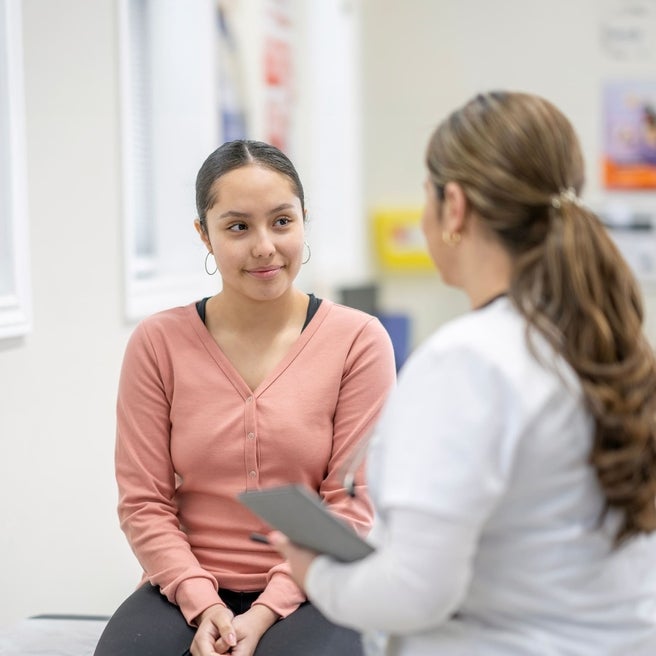What are PMS and PMDD?
Most people experience some unpleasant or uncomfortable symptoms during their menstrual cycle. For some, the symptoms are significant, but short in duration and not disabling. Others, however, may have symptoms that temporarily disturb their normal functioning. The symptoms may last a few hours or many days, and the types and intensity of symptoms can vary from person to person.
This group of symptoms is referred to as premenstrual syndrome (PMS). Although the symptoms usually stop when the menstrual period begins, in some people the symptoms continue during and even after their menstrual periods. Premenstrual dysphoric disorder (PMDD) is a more severe and disabling form of PMS.
Studies have shown that in the United States, as many as 80 percent of women experience PMS signs and symptoms. About 5 percent have signs and symptoms severe enough to be diagnosed with PMDD. Adolescents can experience signs and symptoms of PMS and PMDD as severely as those experienced in adults.
Signs and symptoms of PMS and PMDD
Symptoms of premenstrual syndrome vary and each female may experience the symptoms differently. The symptoms of PMS and PMDD may resemble other conditions or medical problems. The following are the most common PMS and PMDD symptoms.
Emotional symptoms include the following:
- Depression
- Angry outbursts
- Irritability
- Crying spells
- Anxiety
- Confusion
- Social withdrawal
- Poor concentration
- Insomnia
- Increased nap taking
- Changes in sexual desire
Physical symptoms include the following:
- Thirst and appetite changes (food cravings)
- Breast tenderness
- Bloating and weight gain
- Headache
- Swelling of the hands or feet
- Aches and pains
- Fatigue
- Skin problems
- Gastrointestinal symptoms
- Abdominal pain
Causes of PMS and PMDD
The cause of premenstrual syndrome is unclear, but seems to be related to fluctuations in estrogen and progesterone levels in the body. Social, cultural, biological and psychological factors have been identified as possible contributors of PMS.
Diagnosis and testing of PMS and PMDD
Adolescents with signs and symptoms of PMS should be referred to clinicians who have expertise in Adolescent Medicine. At Children’s Hospital of Philadelphia, these young people are evaluated by our Adolescent specialists.
At Children’s Hospital of Philadelphia (CHOP), diagnosis of PMS begins with a series of questions about the patient’s overall medical history, menstrual cycle, symptoms any sexual activity. A physical examination follows, which may include a pelvic examination.
At CHOP, we welcome parents and caregivers as key partners in supporting a young person’s care during and after treatment for PMS.
To help young people develop the skills needed to be responsible for their own health, clinicians typically ask to spend time alone with patients during each visit. This helps young people become comfortable talking with their healthcare providers about their concerns and allows patients to ask questions that may be more difficult to say in front of their parents and caregivers. We respect the privacy and confidentiality of our young patients, while ensuring that young people are safe and connected to the appropriate services and resources they need.
Currently, diagnostic procedures to diagnose PMS are very limited. Clinicians may recommend a psychiatric evaluation to rule out other possible conditions, or ask the adolescent to record their symptoms in a journal or diary for several months to better assess the timing, severity, onset and duration of symptoms. Bloodwork or other tests may be ordered if other medical conditions are suspected.
Treatment for PMS and PMDD
Treatment for PMS may require a coordinated approach. At Children’s Hospital of Philadelphia, adolescent medicine specialists work closely with specialists from behavioral health or endocrinology if needed to accurately diagnose and treat mood-related menstrual issues.
Treatment for PMS will be determined by your adolescent’s healthcare provider based on:
- Your adolescent's age, overall health and medical history
- Extent of the condition
- Current symptoms
- Your adolescent's tolerance for specific medications, procedures or therapies
- Expectations for the course of the condition
- Your adolescent's opinion or preference
At CHOP, treatment for PMS often begins with counseling with an adolescent medicine provider who can help your adolescent better understand their condition and what they can do to improve symptoms.
For some young people, making simple lifestyle changes can help to reduce the frequency and intensity of PMS symptoms. These changes may include:
- Exercising regularly
- Dietary changes
- Getting adequate sleep
- Avoid smoking or use of alcohol
For patients who are not helped by lifestyle changes, treatment for PMS symptoms may include:
- Nonsteroidal anti-inflammatory medications, such as ibuprofen or naproxen
- Hormonal medications
- Relaxation training, coping skills training, or cognitive behavioral therapy (CBT)
- Dietary supplements
- Mind-body treatments
- Antidepressants or other medications for PMDD
Resources to help
Adolescent Medicine Resources
We have created resources to help you find answers to your questions about health issues that become more relevant during your child's teen years.
